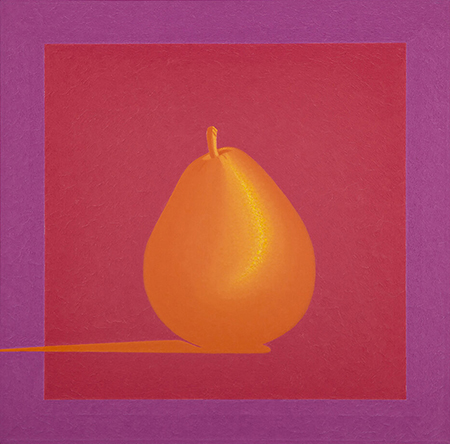
Previously I have written for Visual Art Source about the late Martha Alf’s representations of intense light that suggests a metaphysical or spiritual consciousness, as exemplified by her brightly colored pear drawings of the early 1980s. A recent posthumous exhibition at Kohn Gallery, which featured nine works from the early 1960s through the late 1980s, expanded our understanding of Alf’s unique approach to representing light and space.
Although Alf is best known for paintings of toilet paper rolls and black-and-white drawings of pears, both of which earned her national recognition in the 1970s, her art of the 1960s includes a series of brooding self-portraits. Created at a time when her primary identity was that of a frustrated faculty wife with no career of her own, the self-portraits were vehicles for questioning who she really was, while simultaneously providing a sense of self-affirmation. Her natural talent is clearly evidenced by the innately expert draftsmanship seen in “Self Portrait #66 (1966).” Additionally, this drawing exhibits three traits that would eventually define Alf’s oeuvre. First, the diagonal striations that would later bathe an entire drawn surface are distinctly visible in the space surrounding the figure. These markings would evolve to become Alf’s favored means of referring to the unseen materiality of space itself. Second, bold light patterns moving across her face and hair foreshadow her later preoccupation with heightened luminosity. And third, her habit of finding inspiration in things a housewife buys in a supermarket is apparent in the style of her silken, perfectly coiffed hair. If we didn’t know better, we might assume that she is one of the “Breck girls” from the ubiquitous shampoo ads of 1960s popular magazines.
In the late 1960s, Alf enrolled in the MFA program at the University of California, Los Angeles, and settled in Venice, seeking to become part of its thriving artist community. Her 1969 drawing “Still Life with Insulator” was made while she was still a student, yet in terms of technical finesse, it has the maturity of a master. The subject matter suggests she was cognizant of fellow Venice resident and UCLA alumna Vija Celmins’ paintings of electrical appliances. Alf’s decision to draw the objects, rather than paint them, allowed her to further develop her technique of representing atmospheric space with diagonal hatching, now extended across the entire compositional surface. This idiosyncratic characteristic yields a quiet ethereality that would lead critics to compare Alf’s drawings of the late 1970s to the metaphysical still lives of Giorgio Morandi.
Although the exhibition includes an exemplary cylinder painting from the series that earned Alf a place in the 1975 Whitney Biennial, a small drawing from the same period reveals that her explorations of toilet paper rolls extended beyond presenting them as monolithic icons. “Untitled #8” (1975) shows a single roll with the last of its paper still attached and cleverly transformed into lively drapery folds. As she would soon do with pears, Alf anthropomorphized an everyday store-bought object, giving it human qualities, and sheathed it in her characteristic ethereal light.
Perhaps the biggest surprise for those only marginally familiar with Alf’s work can be found in the staying power of the exhibition’s three psychedelic pear paintings from her “Inner Square Series” of the late 1980s. Although largely overlooked at the time they were first shown, these playful parodies of Josef Albers’ “Homage to the Square” paintings demonstrate Alf’s superb ability to fuse representation and abstraction, long considered incompatible, to create imagery that is visually logical, coherent and forceful. Since Alf considered her fruits and vegetables to be metaphoric surrogates for actors on a stage, these pears may be interpreted as strong, healthy, exuberant human beings. Considering that Alf self-identified with the pear, the series might also loosely be viewed as self-portraits of a confident artist choosing to try something new. Additionally, with a radiant isolated blast of light on each pear and surfaces that breathe life due to subtle allover movements of the brush, the series is emotionally uplifting. In an abbreviated selection, the exhibition neatly summarizes Alf’s masterful legacy.
